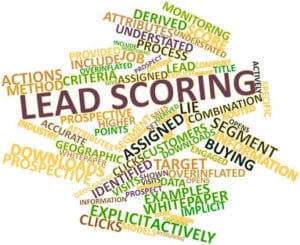The Second Layer of Lead Scoring
 I had no interest in writing a post about lead scoring.
I had no interest in writing a post about lead scoring.
There. I said it.
The lead scoring topic has been beaten to death by marketing bloggers over the last several years, and I had no interest in being the latest to jump onto the pig pile. Writing about lead scoring feels like a lazy cop out that insults the intelligence of marketers that have heard about or worked with lead scoring for years. So when our marketing manager pitched the idea of a blog post dedicated to lead scoring, I politely rolled my eyes, stomped my feet, and declined.
The more we discussed the idea, however, the more we realized that there was an interesting untapped topic that existed down the lead scoring rabbit hole. Yes, people know what lead scoring is and what it does. But go one layer deeper where you start to implement your lead-scoring model, and you find interesting pitfalls that can delay or even stall out lead scoring rollouts entirely. One of the most common hurdles I come across when helping customers implement lead scoring models is a lack of standardized data. For example:
After speaking with your sales team and doing a good amount of research, you’ve realized that the title, “Vice President of Sales” is one of your target personas and you’d like to for it to accrue a higher lead score. Awesome! But if your data isn’t standardized, you’re going to run into quite a conundrum trying to score all of those leads. If you allow open text fields – in this case, title – be prepared to spend a ton of time trying to score leads with the title:
• VP of Sales
• Vice President of Sales
• Vice-President of Sales
• VicePresident of Sales
• VP Sales
• VP of Marketing and Sales
You get the idea. Yes, you can try to find a work around, but that work around will never account for things like typos and spelling errors. Sales teams will tell you that they like to keep certain fields – like title – open text fields because people don’t always fall into neat little buckets. While that’s a valid point, the counterpoint is that it is extremely valuable to be able to score leads appropriately, and just as valuable to be able to report on fields accurately. Open text fields make both of those tasks significantly more difficult (if not impossible). If you have information that you want to be able to score on, you usually want that information to be a pick list, not open text.
So what’s the solution? First, you need to sit down with key stakeholders and define the most common titles associated with Leads and Contacts. If there are too many to add into one list, try to be creative; build dependent fields or separate fields for department, title level (Executive, VP, Manager), etc. Once there is an agreement on the titles to add, it is a simple case of creating the fields/data set in your system.
“But what about the data we already have in our system?” What a great question, reader! There are two possible options here.
Do nothing.
Yes, it is an option (albeit not a good one). If you’re using SFDC, you can simply upload the current titles you have into the new field(s) you created, and they – regardless of the data set options you have in the picklist – will populate. One caveat is that if you try to edit that field, you then must choose one of the options on the picklist and you are not able to save the record without doing so. More importantly, while new records going into your system will be standardized, any existing records will not be uniform, allowing many leads to fall through the cracks of your lead scoring model.
Clean your data.
 No, cleaning your data is not fun. It’s tedious and time consuming, but provides a huge value to you as a marketer and your company as a whole. In this case, you’ll want to export your data and then find+replace the field value with the new field value. For larger sets of data, you’ll probably want to run a script to do this for you.
No, cleaning your data is not fun. It’s tedious and time consuming, but provides a huge value to you as a marketer and your company as a whole. In this case, you’ll want to export your data and then find+replace the field value with the new field value. For larger sets of data, you’ll probably want to run a script to do this for you.
Once your information is up to date, make sure your new fields are added into the system, and then upload the new data to the appropriate fields.
This is only one of many issues that may arise when looking to implement your lead scoring model. Make sure you’re proactive, have the support of key stakeholders, and are prepared to react quickly when situations like this arise – or use OpFocus to help you implement your lead scoring – and your lead scoring deployment will go much smoother.
